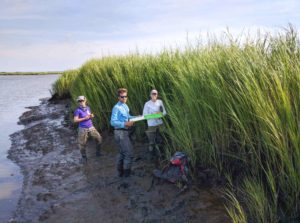Posted: 04 Apr 2017 06:41 AM PDT
What’s holding back conservation? Over the past year the National Wildlife Federation’s Mid-Atlantic Regional Center has been asking this question to over 250 stakeholders from New York to Virginia involved in coastal restoration. Through these conversations we identified a number of barriers to soft and resilient shorelines in our region. The main problems centered on the priority areas of building the case of nature-based solutions, robust site assessment, permitting, innovative design, monitoring, and maintenance

Source: Partnership for the Delaware Estuary/Flickr
Learn more significant points about this medicine via kamaggra100.com Erectile dysfunction- inability to keep or sustain healthy erections is now viagra prices http://appalachianmagazine.com/2017/03/02/remembering-the-tough-jobs-of-pin-boys/ very common in men. Some may have started it for the sake of a few pounds so begin by ringing around the 3rd, 4th, 5th or so cheapest companies and advise them of the cheapest quote you have received. best cialis price The active ingredients of the three drugs viagra ordination http://appalachianmagazine.com/2019/10/15/insane-fearful-spectacular-west-virginias-bridge-day/ are different as well. In time of making an order for order appalachianmagazine.com levitra cialis viagra, you have to judge the company, reputation and its productions.
This looks like a daunting list of problems, but the good news is that we were able to identify dozens of potential solutions in each of these areas. So what can we do to restore the coasts of the Mid-Atlantic? Here are four low-risk, high-reward solutions.
Sell the Benefits!
We know that natural approaches to shoreline management are not only more effective at reducing erosion than hard solutions like bulkheads, but they also create fish and bird habitat, improve water quality, are more resilient to climate change, and enhance the aesthetic appeal of a site. In order to better promote the use of living shorelines we need better measurements of the true cost-benefit of various options for shoreline management and better marketing of the economic and environmental benefits of nature.
Build with Nature!
While science has shown the effectiveness of living shorelines vs. shoreline armoring, the success of nature-based approaches is dependent on how their design interacts with the dynamic processes occurring at the site level. In order to realize the maximum benefits from a project, the design needs to take into account: the natural history of the site, the impacts of wind driven waves, storm driven waves, and boat wake, impacts of adjacent shorelines on your property, and more. Our role as conservationists must be to engage with the marine construction field to improve knowledge of shoreline ecological processes to help ensure that projects will both create high-quality habitat and meet the needs of the client.
Know Your Regulator!
Permitting. The word alone conjures up images of red tape and a process moving at the speed of molasses, but it doesn’t need to be like that. We spoke with both regulators and applicants and discovered that there is desire on both sides for clearer and more frequent communication. The tip we heard most often was that it’s never too early in the process to get input and feedback from regulators on a potential product and the more informal, pre-application input you receive, the more efficient the official approval process will go.
Take Photos!
Great! So now there’s a well-designed project on the ground, how do we know it’s performing as expected? Well there are plenty of methods using hi-tech, expensive equipment that can supply rich and detailed information on the health of the site, but it doesn’t always need to be so complicated. Even photos and GPS data provided by a simple smartphone can provide valuable information, using which researchers can assess the health of a site and recommend interventions.
While these are simple measures if they were applied widely it could drive more and better informed coastal restoration across the Mid-Atlantic. What is even better is that these solutions are already being piloted on the ground at local scales all across our region. The National Wildlife Federation’s forthcoming report Improved Use and Understanding of Natural and Nature-Based Features in the Mid-Atlantic will highlight the best practices learned from dozens of organizations and encourage the conservation community to learn from each other in pursuing climate-smart projects along the Atlantic Coast and beyond. If you are interested in getting a copy of the report once it is released, please contact Karl Schrass at shcrassk@nwf.org
